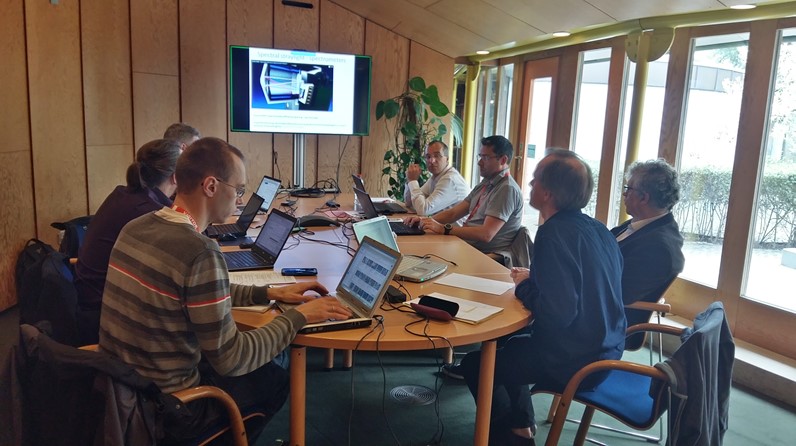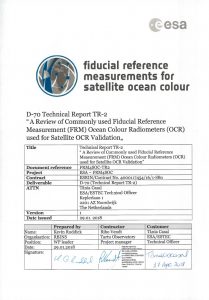Riho Vendt (TO), Tiia Lillemaa (TO), Kevin Ruddick (RBINS)
May 2018
The concept of Fiducial Reference Measurements (FRM) has been introduced to build confidence in satellite data product quality over the entire end-to-end duration of a satellite mission. Building confidence is achieved by independent validation of measurement results and establishing a traceability chain to the units of SI with accompanying uncertainty evaluation. The total uncertainty estimate involves components arising from: the type of instrument used, the instrument calibration, the protocol and data processing methods, and the spatio-temporal characteristics of the satellite-ground “matchup” measurements. Measurement instrumentation has a major role in this chain and therefore, it is of prime importance to accurately estimate the uncertainties of measurements used for satellite Ocean Colour Radriometer (OCR) validation.

Most of the commonly used OCR types were represented in the FRM4SOC comparison exercises. An example from the FRM4SOC LCE-2
In the framework of the FRM4SOC project there has been made an activity to gather information on different designs and performance of all commonly used OCR. For that purpose, manufactures of OCR were invited to participate in the activities of FRM4SOC, such as comparison measurement exercises LCE-1, LCE-2, and provide input to the dedicated study in the level of detail that is required to construct a full uncertainty budget for instrument-specific aspects.
It is notable that manufacturers, despite the strong competition in the field, all considered it important to contribute together to the reliability of measurement data. The manufacturers stated that the gathering helped them to learn about the best measurement methods and see how uncertainties are taken into account. They also noted that it provided them with ideas of improving the measurement protocol and perhaps moving towards a new generation of instruments. The participants also benefited from the gathering by widening their network. It was stressed that the exercise might be used as prime example for similar activities.
To our knowledge, it was also the first time, when all major manufacturers gathered together at ESTEC on 6th September 2017 to discuss uncertainty evaluation issues and common approach for characterization of OCR.

First round table seminar of the manufacturers of OCR at ESTEC on 6th of September 2017
As the result of these activities a comprehensive report describing commonly used OCR was produced.
This report does not try in any way to identify a “best” instrument. This would be an impossible task, especially since there are no objective criteria on which to define “best” and, as will become apparent on reading this review, there is by no means sufficient information to perform any kind of fair comparison. The current document also does not document instrument cost and certainly does not attempt to evaluate “value for money”, which is important for users but clearly outside the scope of our study. Rather the objective of the present report is to document what is already known about the performance of the various instruments, according to traceable references, and identify what still needs to be characterized in order for validation users to construct a full uncertainty estimate for instrument-related factors.
We hope that the present report will help understand what information is or currently is not available for preparation of a FRM uncertainty budget, so that these users will be able to make informed purchase decisions and request the relevant information on radiometer characterisation from their suppliers.
Similarly this process should reward the efforts of the most conscientious instrument manufacturers, who perform careful characterization tests and provide this information to their customers and to the scientific public and space agencies that use data from these instruments for satellite validation purposes.
This report is, therefore, a step in a process towards Fiducial Reference Measurements and will, hopefully, be followed up by activities of the instrument manufacturers, the FRM4SOC Project Team and individual validation scientists to better understand the performance and uncertainties of Ocean Colour Radiometers.
The full report “D-70 Technical Report TR-2. A Review of Commonly used Fiducial Reference Measurement (FRM) Ocean Colour Radiometers (OCR) used for Satellite OCR Validation” is available here.

